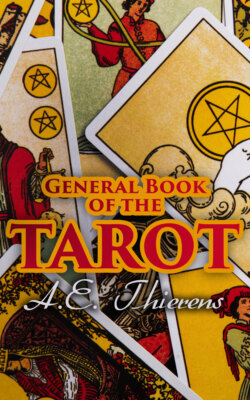Читать книгу General Book of the Tarot - A.E. Thierens - Страница 4
I THE DOCTRINE
ОглавлениеThe knowledge of the Tarot, handed down to us through the ages, and as we find it at the beginning of the XXth century, can be traced in the writings of many authors. Its most perfect interpretations until now are to be found in the works of Éliphas Lévi (Dogme et Rituel de la Haute Magie) and Dr. Papus (Le Tarot des Bohémiens and Le Tarot Divinatoire). These may be said to represent the best results of earlier times, including Eteilla and P. Christian.
A booklet by S. L. MacGregor Mathers, an author well known for his works on subjects relating to the Kabbalah, quotes J. F. Vaillant (1857) as saying "that it (the Tarot) belongs to the beginning of our time, to the epoch of the preparation of the zodiac . . ." and ". . . The great divinity Ashtarot, As-Tarot, is no other than the Indo-Tartar Tan-tara, the Tarot, the Zodiac."
This is curious, and we wonder if one or the other ever worked out so much as a real scheme of this relationship between the Tarot system and the zodiacal principles. If so, as far as we know, it did not appear publicly.
Another well-known author on ancient mysteries and symbolism, Arthur Edward Waite, who revised and introduced an English edition of Papus' Tarot of the Bohemians, by A. P. Morton, has presented us with a still more precious booklet entitled The Key to the Tarot, from which we quote:
"The Tarot is symbolism; it speaks no other language and offers no other signs."
And we would add that true symbolism is always the figurative rendering of cosmological truth or natural principles and laws in visual linguistic or mental image. If astrological symbolism does the same, why should we not seek for a correlation between the two systems? And if further we come to the conclusion, as we must, that both systems give a rendering of the process of creation itself, totally and definitely, then the two must practically present the same point of view, and a comparison between them must not only be instructive but may elucidate both.
In the present work, it is our ardent desire to join with Mr. Waite, "so that the effect of current charlatanism and unintelligence may be reduced to a minimum."
We shall abstain from any special criticism and pass over the more ancient literature on the subject--by such writers as Eteilla, Court de Gebelin, P. Christian, etc.--literature which has been mostly embodied in the works mentioned above, which we specially recommend to those readers who wish to study the subject exhaustively. The best Tarot cards are those drawn by Miss Pamela Colman Smith, published in England, and issued with Mr. Waite's booklet. The designs on these cards appear to be the most pure in their symbolical details, and to be drawn with inspiration and clear vision, though in general the ancient description or traditional rendering has evidently been followed.
The symbolical system of the Tarot consists of 78 picture cards of which 22 constitute the Major Arcana or Trumps Major, 56 (4 × 14) the Minor Arcana, Trumps Minor. As far as we know the idea of analogy with the zodiacal mysteries has, until now, found no further practical realisation than a rather diffuse comparison of the four 'colours' or suits in the Lesser Arcana with the Four Elements in the Cosmos, as we find them in astrology.
